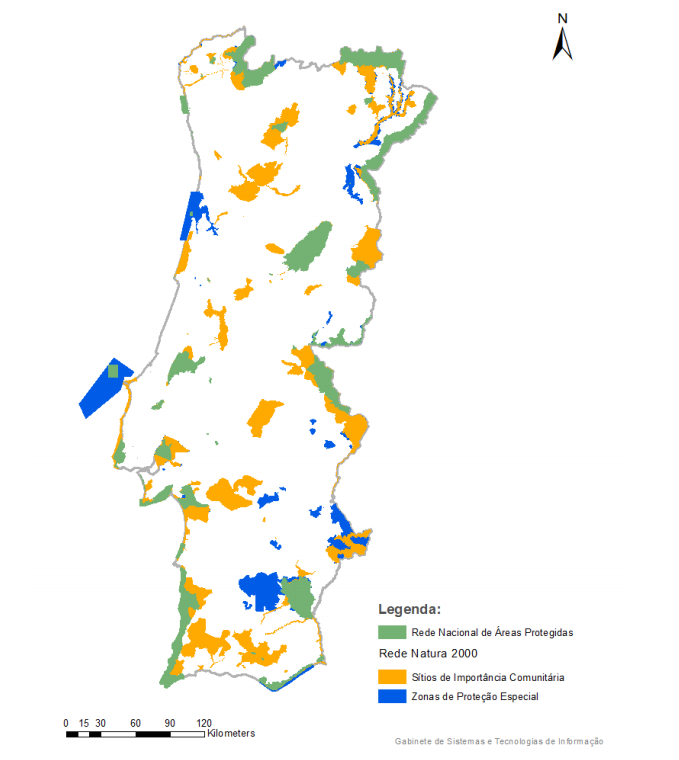The North Coast Special Conservation Zone (SCZ) is presented as a linear strip, along the coast.
It is located on a platform that extends to the adjacent hills, whose geological history includes a set of marine regressions and transgressions and a coastal lagoon scenario. The existing agricultural veins were already currently submerged, as well as the area currently submerged shows signs that the marine front was at a more remote time, being possible to observe traces of these events in the area.
The space surrounding this site has always been greatly altered by man, with evidence of human presence along the entire rocky coast north of the Lima River, from the Paleolithic to the present day, namely utensils carved in quartzite pebbles, salt pans , engravings on rocks, fisheries or camboas and coastal fortifications.
The forest spaces adjacent to this zone are currently mainly composed of maritime pine (Pinus pinaster), with the exotic tree species (acacias and mimosas) gradually occupying an increasingly larger area, due to degradation of the pine forest or invasion of dune systems.
About 40% of the Sítio Litoral Norte area corresponds to characteristic biotopes with sandy coasts. However, although it represents only <5% of the site area, the rocky coast has a significant representation in the municipality of Viana do Castelo, being predominant to the north of the Lima River.
The North Coast Special Conservation Zone extends over 2540 hectares, with 2048 ha corresponding to the land area and 492 ha to the marine area. About 27% of the area of the SCZ (754 hectares) is within the boundary of the municipality of Viana do Castelo.
In this SCZ, there are 19 biotopes of Annex I of the Habitats Directive, 3 of which are considered priority. In the Atlantic Biogeographic Region of Portugal, the biotopes with the codes 1230 - Cliffs with vegetation on the Atlantic and Baltic coasts and 2150 - Atlantic descaled fixed dunes of the Calluno-Ulicetea Alliance are exclusive to this SCZ.
It is located on a platform that extends to the adjacent hills, whose geological history includes a set of marine regressions and transgressions and a coastal lagoon scenario. The existing agricultural veins were already currently submerged, as well as the area currently submerged shows signs that the marine front was at a more remote time, being possible to observe traces of these events in the area.
The space surrounding this site has always been greatly altered by man, with evidence of human presence along the entire rocky coast north of the Lima River, from the Paleolithic to the present day, namely utensils carved in quartzite pebbles, salt pans , engravings on rocks, fisheries or camboas and coastal fortifications.
The forest spaces adjacent to this zone are currently mainly composed of maritime pine (Pinus pinaster), with the exotic tree species (acacias and mimosas) gradually occupying an increasingly larger area, due to degradation of the pine forest or invasion of dune systems.
About 40% of the Sítio Litoral Norte area corresponds to characteristic biotopes with sandy coasts. However, although it represents only <5% of the site area, the rocky coast has a significant representation in the municipality of Viana do Castelo, being predominant to the north of the Lima River.
The North Coast Special Conservation Zone extends over 2540 hectares, with 2048 ha corresponding to the land area and 492 ha to the marine area. About 27% of the area of the SCZ (754 hectares) is within the boundary of the municipality of Viana do Castelo.
In this SCZ, there are 19 biotopes of Annex I of the Habitats Directive, 3 of which are considered priority. In the Atlantic Biogeographic Region of Portugal, the biotopes with the codes 1230 - Cliffs with vegetation on the Atlantic and Baltic coasts and 2150 - Atlantic descaled fixed dunes of the Calluno-Ulicetea Alliance are exclusive to this SCZ.
Location
The North Coast SCZ has a total area of 2,540 ha, along the north coast of Portugal. It presents itself as a more or less linear strip, covering the municipalities of Caminha (392 ha), Esposende (712 ha) and Viana do Castelo (754 ha).
Coordinates
Lat: 41.68416320458174
Long: -8.832790119791934
Discover the Natura 2000 Network
Find Points of Interest in the North Coast SCZ
Hello little one!
I'm Piquinhos and I can help you learn more about the Geopark!
Natura 2000 Network
Rede Natura 2000
The Natura 2000 Network is an ecological network for the European Union community space created with the aim of ensuring the conservation of habitats and biodiversity in the Community territory, through the conservation of biotopes and species. It results from the application of the Birds Directive (79/409 / EEC) and Habitats Directive (92/43 / EEC), having been transposed into Portuguese legislation by DL 49/2005, of 24 February. It constitutes an instrument of territorial management in which the guidelines for territorial management are established in the SCZ and SPA, as well as the measures for the conservation of species and habitats.
It is formed by the following classified areas:
- Special Protection Areas (SPA), established under the Birds Directive, aimed at protecting bird species and their habitats;
- Special Conservation Zones (SCZ), established under the Habitats Directive, created by Member States from Sites of Community Importance (SCI), to which the necessary measures are applied to maintain or restore the favorable conservation status of habitats or of species.
In the area covered by the NATURA 2000 Network, human activities must be compatible with the conservation of habitats and species contained in the Annexes of DL 49/2005, of 24 February, with a view to ecologically sustainable management.
The municipality of Viana do Castelo comprises three natural areas of community importance, classified under the Natura 2000 Network, which occupy 15% of the territory: North Coast SCZ , Lima River SCZ and Serra D’Arga SCZ.

Child Mode
Discover the geopark in a simpler format, aimed at the little ones.
Clique ENTER para pesquisar ou ESC para sair


